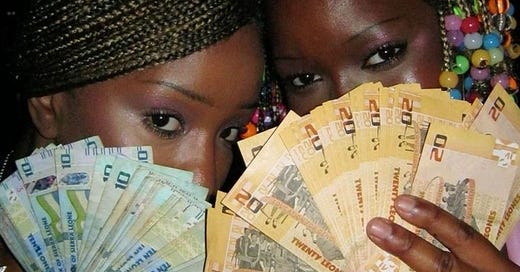Reflecting: Art Writing and Congolese Trade
Canadian artist Rose Katembo reached me to help with a London visa by featuring her. By writing about her, I learned about central African politics.
I only check my Instagram on my laptop, although I download it to my phone on Thursdays for gallery hopping. An artist, Rose Katembo, DMed me last week, and if we didn’t have some mutuals, I might have spammed it. She wanted my help getting a visa, so she asked that I write about her so she could get one.
The article I wrote for Rose Katembo is below:
I write about contemporary art, design, and culture. A few emails and texts later, I was doing background on her based on the artist statement and assets she sent me. This sent me down a rabbit hole at 1:00 am on a Wednesday, not about her but about the Democratic Republic of the Congo (DRC). It didn’t matter that I had work the next day.
I started with a background about art in the DRC. I learned about the Librist Group (1997) in Afterall and read about the common thread of language-based art by Katembo’s reference to Sammy Bolaji. My background info on Africa’s art economy comes from an article I wrote in 2024 that was never published (so it goes—leave a comment if you want me to publish it on Substack). My background expanded my knowledge base, not in the space of art history, but in world trade, political history, and the vestiges of European imperialism.
For y’all who don’t know, the DRC is a Central African country. Surprisingly, major imports are things like delivery trucks, stone processing machines, and iron structures, which are support materials for exporting. The DRC’s greatest trade partner is China ($14.3 B), followed by the United Arab Emirates ($1.45 B) and then India ($684 M).
According to the Observatory of Economic Complexity (OEC), DRC’s greatest exports are refined copper, cobalt, and raw copper. These minerals are found in first-world items like rechargeable battery electrodes, iPhones, lithium-ion batteries, airplane engines, and even things like ink and metallic recording materials. You can read more about cobalt below:
On trade, the DRC has relatively low art exports. The OEC calculates its greatest art imports are from France, and its greatest market growth is in Switzerland. The DRC’s art scene is developing contemporary art. Artists like Katembo, Freddy Tsimba, Sarah Ndele, and Sammy Baloji, among others, display their resilient practices to process colonial grief and exploitation by expressing it across multimedia. Their expressions echo that the Africa we hear about and the Africa we know today won’t be tomorrow’s Africa because tomorrow’s Africa will be free.
The Africa we know today was only drawn up in 1885 during the Berlin Conference. Pre-colonial Africa had totally different territorial and tribal borders. According to Africa Rebirth, Africa was named “Alkebulan”, which translates to “mother of mankind” by Kemetic people. “Africa” as we know its name and division is colonially defined.
The Democratic Republic of Congo was “gifted” to Belgium in 1885 during the Berlin Conference, and it gained independence in 1960. The Berlin Conference and the Scramble for Africa were things I learned about in college, but the RECENT activity of colonization was shocking, and the more I read, the more shocked I was. I say recent for two reasons: American slavery was abolished in 1864 and Africa as we know it was drawn up in 1885.


Considering how there are potentially 700-3000 languages spoken in Africa, the potential for territorial and tribal division is expansive. The Murdock map goes to show the approximate destructive scale of the Berlin Conference and the Western colonization of Africa.
More dates: the Congolese genocide, in which anywhere from 1.5 million to 13 million people were killed, was from 1885 to 1908, the DRC gained independence in 1960, and Palestine was first occupied by Israel in 1967 (yes, it’s connected). Congo elected Patrice Lumumba as their prime minister in 1960, and it took ONE year before he was dead under the most egregious circumstances, which are only being brought to full public light in 2023 (arguably 2000 for the girls who were into Pan-Africanism then).
Do you wanna know how Palestine and the DRC are connected?
I’m academic adjacent, so here’s a list of my sources for easy access:



